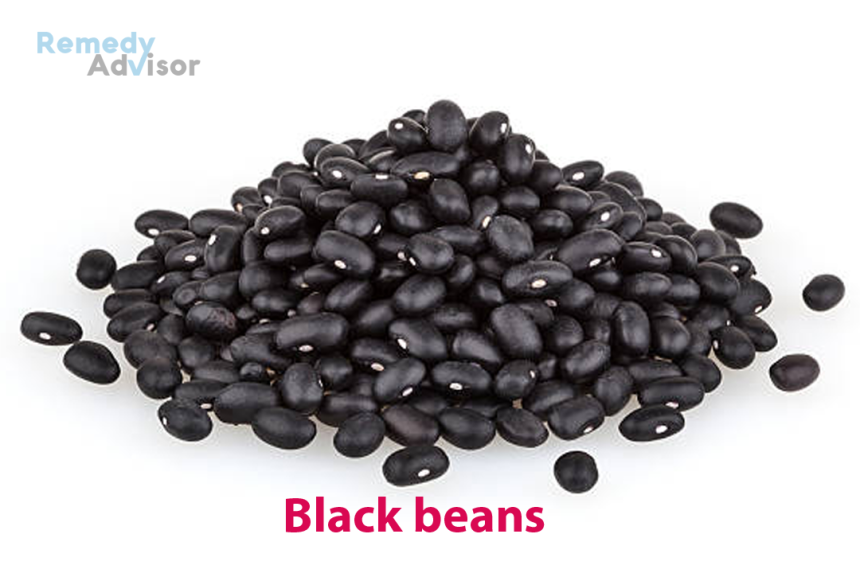One of the reasons people sometimes give for their failure to eat a healthful diet is the expense. These people maintain that eating better is just too costly, especially during difficult economic times. But that is not necessarily true. For example, black beans are often cited as a wonderful example of an inexpensive, nutritious food.
Black beans are believed to be helpful in lowering cholesterol levels, and their high amount of fiber prevents sugar from rising rapidly after a meal. That makes them desirable for people with diabetes. Black beans are considered an excellent source of the trace mineral molybdenum, which is used to detoxify sulfites. They are thought to be a good source of dietary fiber, foliate, tryptophan, manganese, protein, magnesium, vitamin Bi, phosphorus, and iron.
Black beans, which are also known as Phaselus vulgaris, are popular in a number of different countries including Brazil, Mexico, Cuba, Guatemala, and the Dominican Republic. They are widely eaten in many other countries, including the United States. But what does the research say?
Overall health
In a study published in 2003 in the Journal of Agricultural and Food Chemistry, Michigan State University researchers tested the antioxidant activity of 12 types of dry beans. Antioxidants eliminate free radicals that have been related to illnesses associated with aging, such as heart disease and cancer. Black beans were found to have the highest amounts of antioxidants. They were followed by yellow, white, red and brown beans in that order. Darker colored beans tended to have more antioxidants than the lighter varieties.
One group of antioxidants, known as anthocyanins, was the most active antioxidant in the black beans. In fact, in a startling finding, researchers determined that the amount of anthocyanins per l00 gram (g) serving of black beans was about ten times the amount of overall antioxidants in an equivalent amount of oranges and about the same amount found in an equivalent serving of cranberries, grapes, and apples. The researchers studied dry beans; when cooked, beans lose some of these anthocyanins. Still, the researchers thought that the cooked beans probably retained a considerable amount of anthocyanins.
The results of a similar study, conducted at North Dakota State University, were published in 2007 in the Journal of Food Science. Black beans, as well as lentils, black soybeans, red kidney beans, and pinto beans, were found to have more antioxidants than yellow and green peas, chickpeas, and yellow soybeans. In addition, the extracts of black beans (and lentils, black soybeans, and red kidney beans) helped slow the amount of time it took to make DDL (or “bad”) cholesterol. In so doing, black beans have the potential to prevent the development of atherosclerosis.”
Cancer prevention
In a Brazilian study published in 2003 in Food and Chemical Toxicology, researchers attempted to evaluate the protective effect that cooked and dehydrated black beans may have on the bone marrow and peripheral blood cells of exposed mice. When the researchers fed the mice a 20 percent black bean diet, they found that the mice experienced a reduction in precancerous cells. This was seen even in those mice that were given an agent to promote the growth of cancer cells. Hoping to identify the component of the beans that impart this protection, the researchers tested anthocyanin. However, when administered at the highest dosage (50 milligrams per kilogram of body weight), the anthocyanin caused DNA damage. The researchers concluded that the interactions of the combination of elements that go into creating black beans are better than any of the beans’ individual components.
In a study published in July 2006 in The Journal of Nutrition, researchers lead by Dr. Elaine Lanza, head of the Colon Cancer Prevention Group at the National Cancer Institute, investigated more than 2,000 men and women over the age of 35 who were diagnosed with precancerous polyps during the six months before the study began. Over the four years of the study, the subjects were asked questions about their diets. Many tried dietary changes to prevent the growth of more polyps. Those who added the most beans to their diets, including black beans, had a significantly reduced risk of recurrence of advanced polyps.
Cardiovascular health

A study published in 2006 in the Archives of Internal Medicine examined the association of intake of protein and blood pressure readings. Included in the study were 4,680 people, aged 40 to 59 years, from China, Japan, the United Kingdom, and the United States. No significant relationships were found between animal protein intake and blood pressure or between total protein intake and blood pressure. However, researchers found a significant inverse relationship between the consumption of vegetable protein, such as black beans, and blood pressure. For every 2.8 percent increase in vegetable protein intake about ¾ cup of black beans for someone on a 2,000-calorie diet there was an average drop of 2.14 millimeters (mm) in systolic pressure and 1.35 mm 7 in diastolic pressure.
Weight control
In a study published in 2009 in The Journal of Nutrition, researchers at the Brigham Young University College of Health and Human Performance in Provo, Utah, examined how the intake of fiber, such as that found in black beans, could influence the control of weight gain in women. The cohort of 252 women completed baseline and follow-up assessments 20 months apart. The researchers found that, “increasing dietary fiber considerably decreases the chance of gaining weight and fat in females, independent of numerous possible confounders, comprising dietary fat intake, physical activity and others.” Why does fiber have such a robust effect? “Fiber’s effect appears to occur mostly through decreasing energy intake over time.”
Diabetes prevention
In a study published in 2009 in the Archives of Pediatrics & Adolescent Medicine, researchers at the Keck School of Medicine at the University of Southern California in Los Angeles attempted to determine if reducing the amount of dietary sugar and increasing the amount of dietary fiber, such as that found in black beans, could help prevent the development of type 2diabetes in Latino adolescents, who are often overweight and at increased risk for diabetes.
The researchers divided 54 overweight teens (average age 15.5) into three groups. One group had one nutrition class per week; a second group had one nutrition class per week and two sessions of strength training per week; a third group served as the control.
At the end of the 16-week study, researchers observed that 55 percent of the adolescents had decreased their sugar intake by an average of 47 g per day, the amount of sugar contained in a can of soda. Fifty-nine percent of the adolescents had increased their fiber intake by an average of five g per day, an amount equal to one-half cup of beans. The adolescents who decreased their intake of sugar averaged a 33 percent decrease in insulin secretion; those who increased their fiber intake had a 10 percent reduction in visceral adipose tissue volume. Both of these factors decrease the risk of type 2 diabetes. The researchers noted that the adolescents who made these relatively modest changes in their diets “showed improvements in key risk factors for type 2 diabetes, specifically in insulin secretion and visceral fat.”
Caveats
Dry and canned black beans are equally nutritious. Yet, in some instances, canned black beans may contain higher amounts of salt. Whenever possible, those beans should be avoided. To further reduce the salt in canned beans, they should be rinsed with tap water.
Should black beans be included in the diet? Of course. However, they should be added gradually. Eating too many black beans too quickly may result in gastrointestinal upset.







